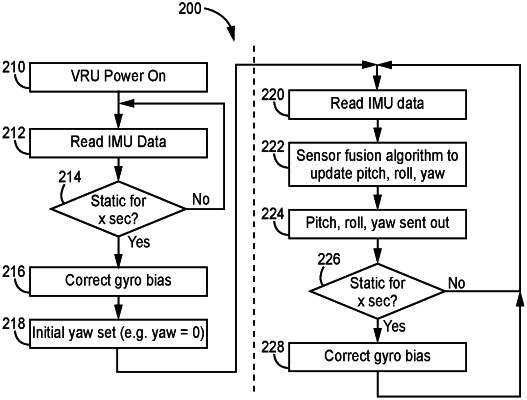| CPC B60W 40/114 (2013.01) [G06F 18/25 (2023.01); B60W 2420/905 (2013.01); B60W 2520/16 (2013.01); B60W 2520/18 (2013.01)] | 19 Claims |

|
1. A system comprising:
a vertical reference unit (VRU) operative to output roll data, pitch data, and unreferenced yaw data for a vehicle, the VRU comprising:
an inertial measurement unit (IMU) including at least one gyroscope and at least one accelerometer, the IMU operative to generate inertial data; and
at least one processor operatively coupled to the IMU, wherein the at least one processor hosts a plurality of processing modules operative to reduce unreferenced heading drift error produced by the VRU; wherein the processing modules comprise:
a first bias cancelation module including instructions to cause the at least one processor to:
read the inertial data from the IMU when the VRU is powered on during start-up;
determine whether the VRU is static for a preselected time period by using a first static detector;
if the VRU is static for the preselected time period, correct gyroscope bias by subtracting an initial gyroscope bias value from a previous gyroscope bias value; and
set a predefined initial yaw value;
a second bias cancelation module including instructions to cause the at least one processor to:
read the inertial data from the IMU during in-run operation of the VRU;
update the roll data, pitch data, and yaw data, based on input data from a sensor fusion algorithm;
output the updated roll data, pitch data, and yaw data;
determine whether the VRU is static for a preselected time period by using a second static detector; and
if the VRU is static for the preselected time period, correct the gyroscope bias by subtracting a current gyroscope bias value, multiplied by a predefined parameter, from a previous gyroscope bias value.
|